A full cheek bit like this may be suitable for a fiddly horse. For less moving parts, choose a single jointed version.
This synthetic gel bit is soft and flexible and the side pieces can be easily exchanged.

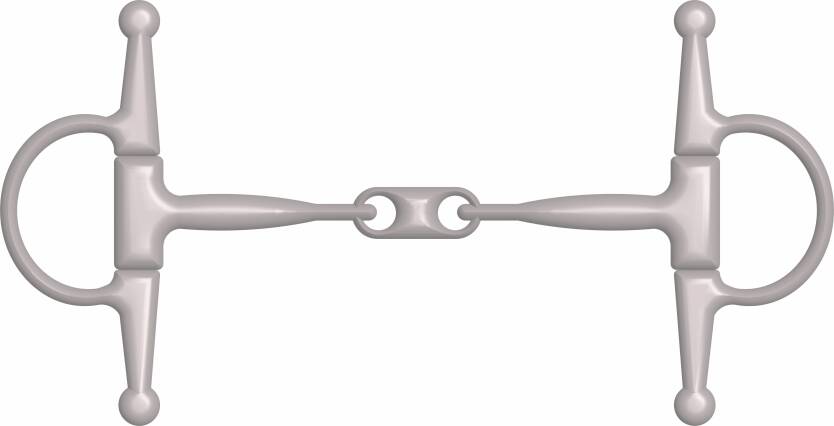
The horse is unsteady in the contact
Consider a bit with minimal movement or fiddly parts to the mouthpiece, as anything that moves, rolls, twists or rotates too much can cause the horse to fiddle with it and therefore become unsteady in the contact.
Moving parts that can suddenly be too sharp or catch the horse’s delicate inner mouth tissue can create an unsteady mouth where they do not trust the bit when it moves. These horses may suddenly shake or toss their head or may hold the bit still in their mouth and feel tense through their jaw. If they do not trust the feel of the bit, they will not be able to respond well to the rider’s aids or understand easily what the rider is asking.
The horse with a sensitive mouth
Some horses can be very negative towards any kind of bit and simply the presence of a bit in their mouth is enough for them to become quite anxious and fussy about. In these extreme cases, I suggest (if it is safe enough) trying a bitless bridle for a while to establish relaxation again under saddle. Then you can introduce a very mild bit again but gradually. Sometimes, I have done this where the bit is in, but the rider is still riding with their bitless setting, so the horse gets to experience being ridden with a bit present, but the pressure is not applied in the mouth. Then you can use two reins and start to use very gentle bit pressure again but still with the bitless rein there as a backup if the horse becomes too worried.
For horses that do not mind a bit but are just sensitive to pressure in their mouths, they tend to go well in bits that do not compress the tongue and bars or provide sharp pressure points.
Synthetic bits that are soft and have some degree of bend to them can be great for horses like this. There are not any features on the mouthpiece to interfere with the mouth, and the material is soft rather than metal, which is hard and can feel too sharp for some horses.
B ut what should you pay attention to when looking for the right bit, how do different bits work, and why is it so important that the bit is fit for purpose for the horse as well for the rider?
O livia Turner combines her knowledge about equine behaviour with her expertise about bits. She states the importance of using certified bit fitters to find the correct bit for your horse.
“If a horse is showing signs of being unhappy with their bit, you should absolutely get it checked by a professional and see if there is something more suitable for you. A change of the bit can work wonders, or it can help highlight that other issues need addressing.”
With an increase in new bits hitting the market, Olivia has found that more horse owners are thinking carefully about the bits they use when they experience problems in their training. Regardless of whether you go for a ride in the forest or compete at a high-level, your equipment must be correctly adapted to your horse and your level of training – the best advice is to get a bit fitter if you experience problems that may be related to the bit fit and suitability. It is our noblest task to ensure that the welfare of our horses comes first.
”You would not expect a horse to perform with a saddle that is too tight and causing back pain, so we should not expect the horse to put up with an uncomfortable
“If the bit is uncomfortable for the horse or does not allow clear communication of the aids, riding and training is going to be more difficult than it needs to be. The risk is that people label the horse as misbehaving rather than assessing the tools they are using and if they are fit for purpose.”
Before you rush into a visit from a bit fitter, you must ensure your horse is healthy and fit. Afterwards, you can – together with a bit fitter adjuster – look at what challenges you and your horse face and how you ride, but bit adjustment can never stand alone.
When we want to ride our horses, we must ensure that the equipment is comfortable, suitable and fitted correctly, so the horse is free from pain and discomfort.
bit that is preventing them from relaxing and feeling ok. A bit change can make a huge difference, so not having it checked, if you have some issues, could really set you back.”
We must get the proper guidance when choosing the right bit for our horses. As equestrians, we are responsible for ensuring the tools we use do not cause the horse discomfort. What works for one horse may not work for another – like with saddles – so a bit fitter can be a good idea.
By Cæcilie Kallehave Jensen. Photos: provided by Olivia Turner & Malgré Tout / Trine Bjørn Puggaard
SOME COMMON INDICATORS OF BITTING PROBLEMS:
Mouth opening or tongue hanging outside of the mouth
Tail swishing
Reefing (grabbing bit and pulling through the rider’s hands)
Chewing or mouthing the bit
Straightness issues
Head tilting
Head shaking
Excessive salivation
Lifting the bit in the mouth or playing with it
Retracting the tongue
Bulging the tongue
Contact evasion or resistance to rider’s aids
High head carriage
Tongue over the bit

ABOUT OLIVIA TURNER
Olivia Turner is an Animal Behaviourist (specialising in horses and dogs) and a bridle and bit expert in the UK.
She has a BSc Hons in Animal Behaviour and Animal Welfare and studied at The Academy in the UK (formed by Neue Schule) to become certified by Lantra in Lorinery Science and Bit and Bridle Fitting. She works daily to improve horses' welfare by assessing any performance issues and ensuring the bits being used fit, is comfortable and allows the rider to communicate clearly with their horse.
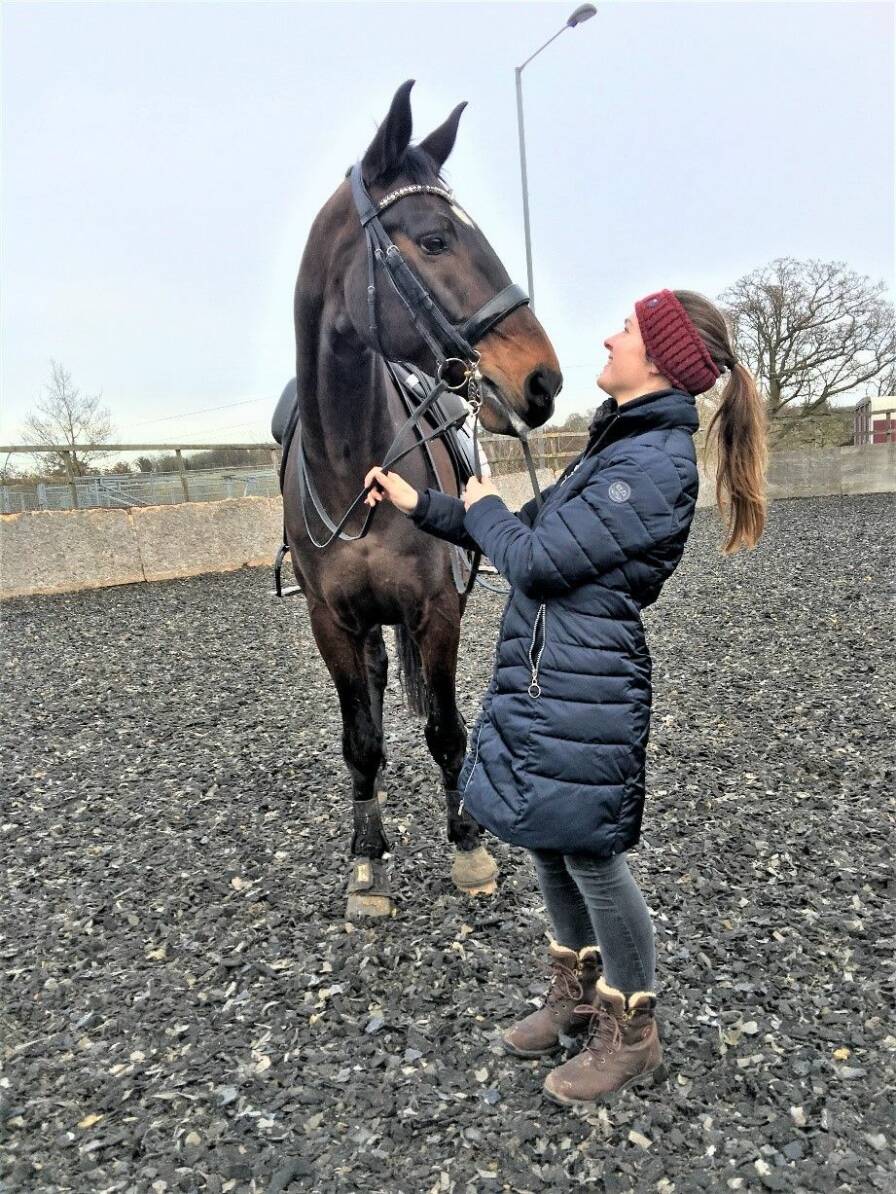
Fit
A leverage bit like this will apply more pressure on the horse.

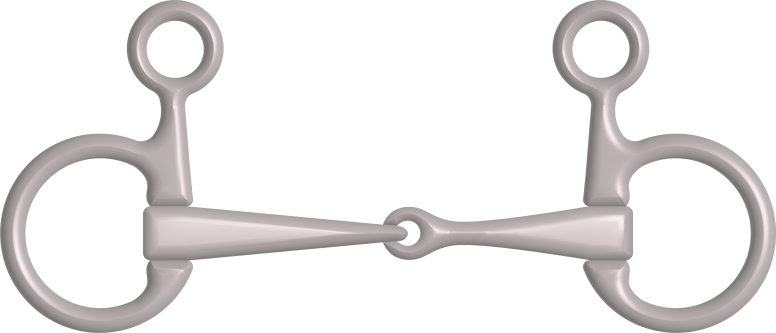
A hanging cheek or baucher bit will lift up in the mouth and focus the pressure into the corners of the lips.
The horse that overbends
Horses that tend to become overbent usually avoid some type of pressure from their current bit and may benefit from bits that encourage more lift through the withers and encourage impulsion from behind to keep their head and neck in a consistent frame.
A hanging cheek or baucher bit will lift up in the mouth and focus the pressure into the corners of the lips whilst reducing pressure on the bars, which can cause the head to lower. It also rotates forwards and relieves any existing poll pressure, allowing the bit to almost float in the mouth. This type of cheek can encourage some horses to lift up through their wither and create an open space to move forward into.
If the horse is struggling to push forward from behind correctly and is therefore becoming heavy in the hand, it may need more stability from a bit and a mild mouthpiece that is soft and forgiving to encourage them to telescope the neck forwards and move into the hand. I find fixed cheeked (e.g. eggbutt, d-ring, full cheek) bits are good for this, and barrel mouthpieces can remove the pressure on the tongue that is typically created by jointed mouthpieces.
Providing stability with the cheek and consistency in the movement of the mouthpiece (a barrel mouthpiece will not change much in the mouth other than rolling along the tongue and the arms rotating independently) can really help these horses trust the contact and come forwards into it.
Alternatively, they could be overbent to avoid bit pressure in their mouth. If the horse bends its nose too far in, the bit will almost float in the mouth and give the rider the feeling they have no contact. Make sure the mouthpiece is soft and accommodating in the mouth and that it allows the horse to move its tongue and jaw freely. Mouthpieces that squash up the tongue too much or apply too much bar pressure (pressure on the lower jaw) may be too strong and cause the horse to overbend in avoidance.
Common mouthpieces that cause this problem are French link-style mouthpieces, where there is a flat plate with large loops that can interfere with the edges of the mouth, inner mouth tissue and create a sharp pressure point on the tongue. Avoid using bits that create poll pressure for horses that become overbent, especially
fixed cheek lever bits like pelhams, as these encourage the head to come down.
The horse pulls on the bit
If the horse is pulling because it is strong and not listening to the slow or stop aids, you can consider a stronger bit or you can consider your training methods. Using a stronger bit means the horse will respond to a lighter aid, allowing the rider to re-train the stop or slow response and then go back to using a milder bit.
A stronger bit usually provides poll pressure (a leverage bit), but you can go stronger by making the mouthpiece sharper e.g., using a plate link, roller or Waterford. However, it must be appreciated that if it is too uncomfortable, the horse may perform a number of different evasions to that pressure, and you can create another problem.
Linking to this are horses that pull because they resist the bit's pressure and therefore feel strong. For these horses, making the bit milder and softer can encourage more relaxation and acceptance which then gives you the control you need.
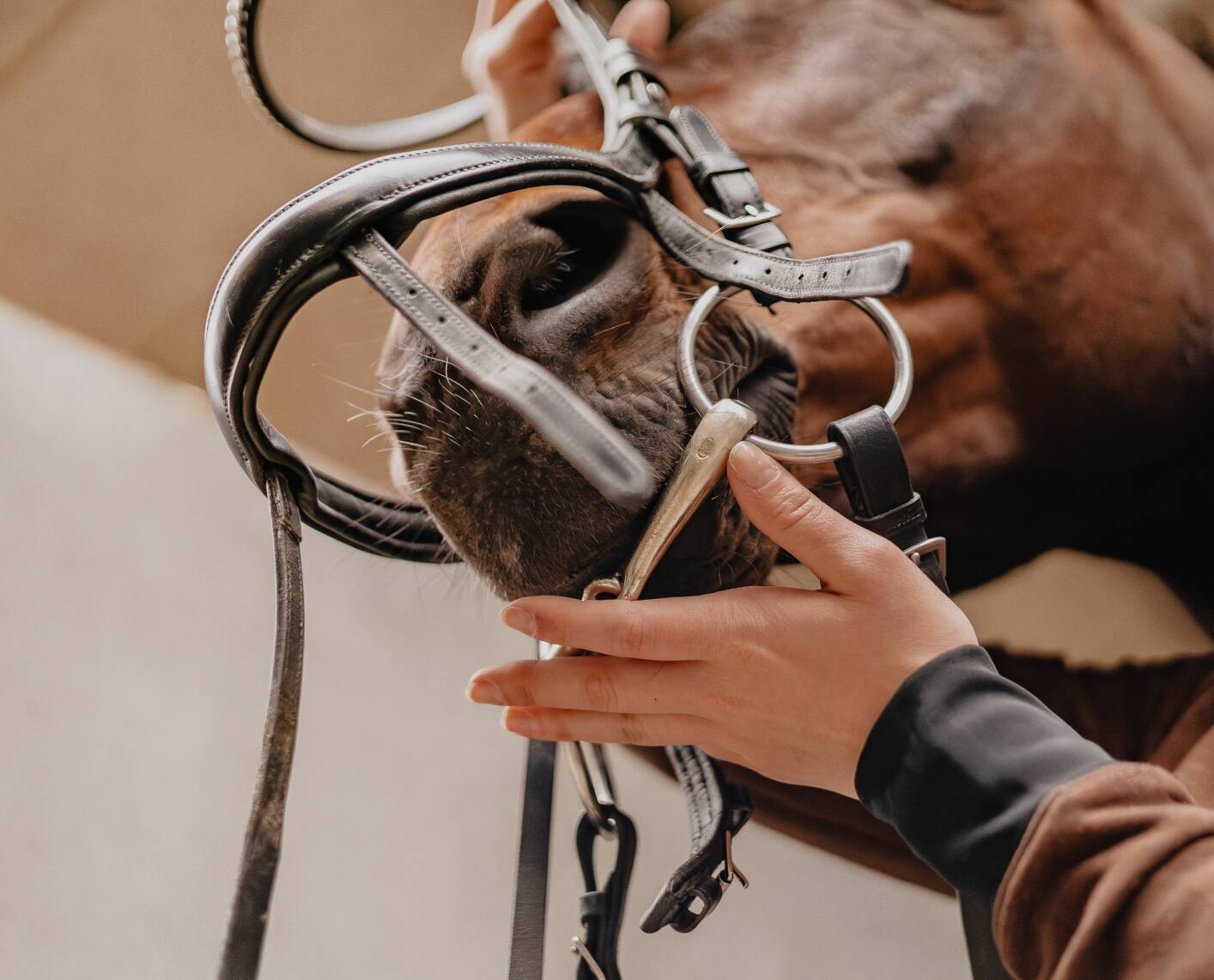
INNOVATIVE BITS
“Bits made from titanium. Titanium is a very lightweight material, which can suit horses prone to rubs or sores from other materials. It is antibacterial, very strong, non-toxic, warm to the touch, and I find it widely accepted by many horses. For me, it is the fact that it is so light in the mouth that it is a great benefit, as many fussy horses go well in this material.”
Four common problems
”The answers to the following points assume the horse is doing those things because of the bit and not another issue. Being overbent or heavy in the hand could be a symptom of a weak hind end and topline, and so on. It is hard to recommend a specific bit for these standard problems as every horse is different and prefers different pressure points,” Olivia Turner explains.
If you experience problems or odd behaviour, you should always have your horse checked by the vet before you look into the bit and the rest of your equipment. This way you can be certain nothing is wrong with your horse.
Bit for purpose
Ensuring that the bit you are using is suitable for your riding level, your riding discipline and your horse’s own preference on how much pressure is applied and where, ensures you are set up to achieve a harmonious ridden relationship with your horse. The horse's mouth is extremely sensitive; therefore, a correctly adjusted bit is just as important as a correctly adjusted saddle.

This synthetic gel bit is soft and flexible and the side pieces can be easily exchanged.

The horse is unsteady in the contact
Consider a bit with minimal movement or fiddly parts to the mouthpiece, as anything that moves, rolls, twists or rotates too much can cause the horse to fiddle with it and therefore become unsteady in the contact.
Moving parts that can suddenly be too sharp or catch the horse’s delicate inner mouth tissue can create an unsteady mouth where they do not trust the bit when it moves. These horses may suddenly shake or toss their head or may hold the bit still in their mouth and feel tense through their jaw. If they do not trust the feel of the bit, they will not be able to respond well to the rider’s aids or understand easily what the rider is asking.
The horse with a sensitive mouth
Some horses can be very negative towards any kind of bit and simply the presence of a bit in their mouth is enough for them to become quite anxious and fussy about. In these extreme cases, I suggest (if it is safe enough) trying a bitless bridle for a while to establish relaxation again under saddle. Then you can introduce a very mild bit again but gradually. Sometimes, I have done this where the bit is in, but the rider is still riding with their bitless setting, so the horse gets to experience being ridden with a bit present, but the pressure is not applied in the mouth. Then you can use two reins and start to use very gentle bit pressure again but still with the bitless rein there as a backup if the horse becomes too worried.
For horses that do not mind a bit but are just sensitive to pressure in their mouths, they tend to go well in bits that do not compress the tongue and bars or provide sharp pressure points.
Synthetic bits that are soft and have some degree of bend to them can be great for horses like this. There are not any features on the mouthpiece to interfere with the mouth, and the material is soft rather than metal, which is hard and can feel too sharp for some horses.
A full cheek bit like this may be suitable for a fiddly horse. For less moving parts, choose a single jointed version.

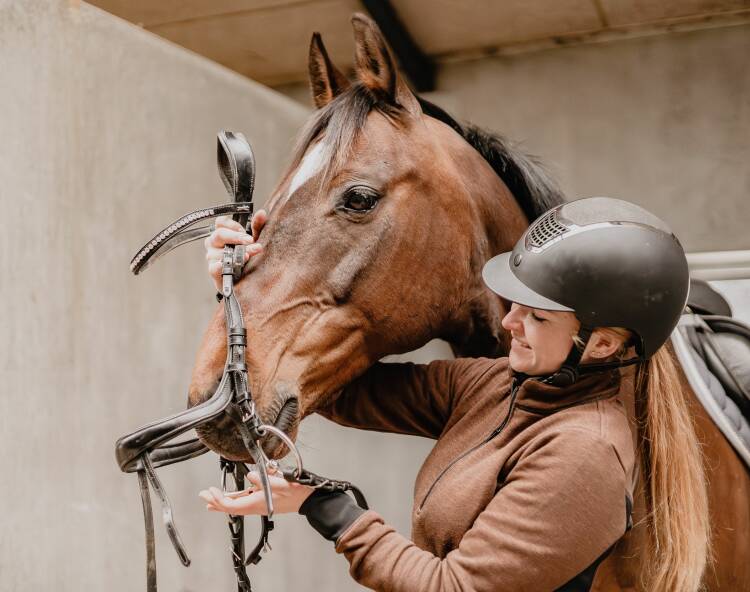
SOME COMMON INDICATORS OF BITTING PROBLEMS:
Mouth opening or tongue hanging outside of the mouth
Tail swishing
Reefing (grabbing bit and pulling through the rider’s hands)
Chewing or mouthing the bit
Straightness issues
Head tilting
Head shaking
Excessive salivation
Lifting the bit in the mouth or playing with it
Retracting the tongue
Bulging the tongue
Contact evasion or resistance to rider’s aids
High head carriage
Tongue over the bit
A leverage bit like this will apply more pressure on the horse.
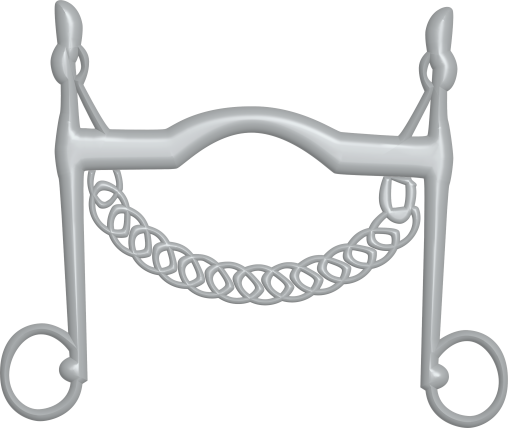
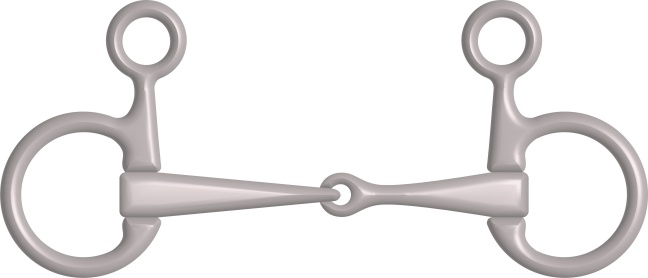
A hanging cheek or baucher bit will lift up in the mouth and focus the pressure into the corners of the lips.
The horse that overbends
Horses that tend to become overbent usually avoid some type of pressure from their current bit and may benefit from bits that encourage more lift through the withers and encourage impulsion from behind to keep their head and neck in a consistent frame.
A hanging cheek or baucher bit will lift up in the mouth and focus the pressure into the corners of the lips whilst reducing pressure on the bars, which can cause the head to lower. It also rotates forwards and relieves any existing poll pressure, allowing the bit to almost float in the mouth. This type of cheek can encourage some horses to lift up through their wither and create an open space to move forward into.
If the horse is struggling to push forward from behind correctly and is therefore becoming heavy in the hand, it may need more stability from a bit and a mild mouthpiece that is soft and forgiving to encourage them to telescope the neck forwards and move into the hand. I find fixed cheeked (e.g. eggbutt, d-ring, full cheek) bits are good for this, and barrel mouthpieces can remove the pressure on the tongue that is typically created by jointed mouthpieces.
Providing stability with the cheek and consistency in the movement of the mouthpiece (a barrel mouthpiece will not change much in the mouth other than rolling along the tongue and the arms rotating independently) can really help these horses trust the contact and come forwards into it.
Alternatively, they could be overbent to avoid bit pressure in their mouth. If the horse bends its nose too far in, the bit will almost float in the mouth and give the rider the feeling they have no contact. Make sure the mouthpiece is soft and accommodating in the mouth and that it allows the horse to move its tongue and jaw freely. Mouthpieces that squash up the tongue too much or apply too much bar pressure (pressure on the lower jaw) may be too strong and cause the horse to overbend in avoidance.
Common mouthpieces that cause this problem are French link-style mouthpieces, where there is a flat plate with large loops that can interfere with the edges of the mouth, inner mouth tissue and create a sharp pressure point on the tongue. Avoid using bits that create poll pressure for horses that become overbent, especially
fixed cheek lever bits like pelhams, as these encourage the head to come down.
The horse pulls on the bit
If the horse is pulling because it is strong and not listening to the slow or stop aids, you can consider a stronger bit or you can consider your training methods. Using a stronger bit means the horse will respond to a lighter aid, allowing the rider to re-train the stop or slow response and then go back to using a milder bit.
A stronger bit usually provides poll pressure (a leverage bit), but you can go stronger by making the mouthpiece sharper e.g., using a plate link, roller or Waterford. However, it must be appreciated that if it is too uncomfortable, the horse may perform a number of different evasions to that pressure, and you can create another problem.
Linking to this are horses that pull because they resist the bit's pressure and therefore feel strong. For these horses, making the bit milder and softer can encourage more relaxation and acceptance which then gives you the control you need.

INNOVATIVE BITS
“Bits made from titanium. Titanium is a very lightweight material, which can suit horses prone to rubs or sores from other materials. It is antibacterial, very strong, non-toxic, warm to the touch, and I find it widely accepted by many horses. For me, it is the fact that it is so light in the mouth that it is a great benefit, as many fussy horses go well in this material.”
ABOUT OLIVIA TURNER
Olivia Turner is an Animal Behaviourist (specialising in horses and dogs) and a bridle and bit expert in the UK.
She has a BSc Hons in Animal Behaviour and Animal Welfare and studied at The Academy in the UK (formed by Neue Schule) to become certified by Lantra in Lorinery Science and Bit and Bridle Fitting. She works daily to improve horses' welfare by assessing any performance issues and ensuring the bits being used fit, is comfortable and allows the rider to communicate clearly with their horse.
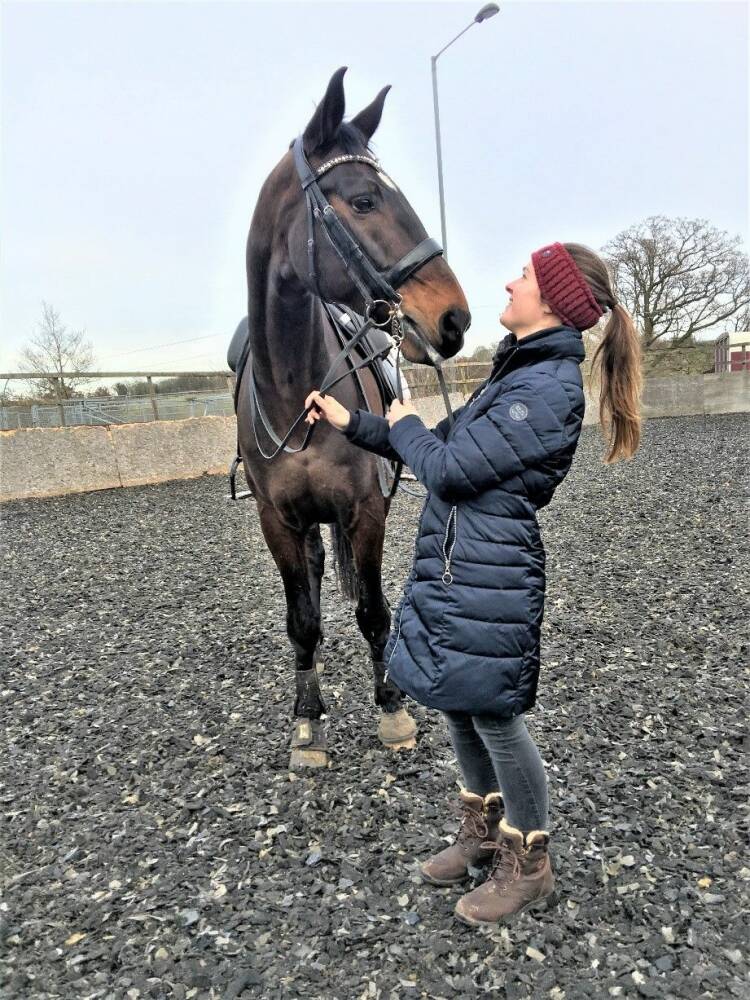
Four common problems
”The answers to the following points assume the horse is doing those things because of the bit and not another issue. Being overbent or heavy in the hand could be a symptom of a weak hind end and topline, and so on. It is hard to recommend a specific bit for these standard problems as every horse is different and prefers different pressure points,” Olivia Turner explains.
If you experience problems or odd behaviour, you should always have your horse checked by the vet before you look into the bit and the rest of your equipment. This way you can be certain nothing is wrong with your horse.
Bit for purpose
Ensuring that the bit you are using is suitable for your riding level, your riding discipline and your horse’s own preference on how much pressure is applied and where, ensures you are set up to achieve a harmonious ridden relationship with your horse. The horse's mouth is extremely sensitive; therefore, a correctly adjusted bit is just as important as a correctly adjusted saddle.
We must get the proper guidance when choosing the right bit for our horses. As equestrians, we are responsible for ensuring the tools we use do not cause the horse discomfort. What works for one horse may not work for another – like with saddles – so a bit fitter can be a good idea.
Fit

By Cæcilie Kallehave Jensen.
Photos: provided by Olivia Turner & Malgré Tout
B ut what should you pay attention to when looking for the right bit, how do different bits work, and why is it so important that the bit is fit for purpose for the horse as well for the rider?
O livia Turner combines her knowledge about equine behaviour with her expertise about bits. She states the importance of using certified bit fitters to find the correct bit for your horse.
“If a horse is showing signs of being unhappy with their bit, you should absolutely get it checked by a professional and see if there is something more suitable for you. A change of the bit can work wonders, or it can help highlight that other issues need addressing.”
With an increase in new bits hitting the market, Olivia has found that more horse owners are thinking carefully about the bits they use when they experience problems in their training. Regardless of whether you go for a ride in the forest or compete at a high-level, your equipment must be correctly adapted to your horse and your level of training – the best advice is to get a bit fitter if you experience problems that may be related to the bit fit and suitability. It is our noblest task to ensure that the welfare of our horses comes first.
”You would not expect a horse to perform with a saddle that is too tight and causing back pain, so we should not expect the horse to put up with an uncomfortable
“If the bit is uncomfortable for the horse or does not allow clear communication of the aids, riding and training is going to be more difficult than it needs to be. The risk is that people label the horse as misbehaving rather than assessing the tools they are using and if they are fit for purpose.”
Before you rush into a visit from a bit fitter, you must ensure your horse is healthy and fit. Afterwards, you can – together with a bit fitter adjuster – look at what challenges you and your horse face and how you ride, but bit adjustment can never stand alone.
When we want to ride our horses, we must ensure that the equipment is comfortable, suitable and fitted correctly, so the horse is free from pain and discomfort.
bit that is preventing them from relaxing and feeling ok. A bit change can make a huge difference, so not having it checked, if you have some issues, could really set you back.”